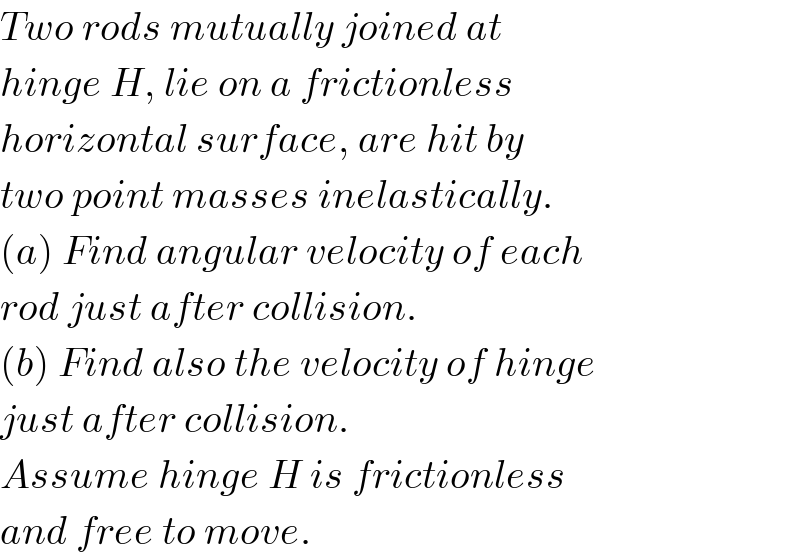Question Number 29093 by ajfour last updated on 04/Feb/18

Commented by ajfour last updated on 04/Feb/18

$${Two}\:{rods}\:{mutually}\:{joined}\:{at} \\ $$$${hinge}\:{H},\:{lie}\:{on}\:{a}\:{frictionless} \\ $$$${horizontal}\:{surface},\:{are}\:{hit}\:{by} \\ $$$${two}\:{point}\:{masses}\:{inelastically}. \\ $$$$\left({a}\right)\:{Find}\:{angular}\:{velocity}\:{of}\:{each} \\ $$$${rod}\:{just}\:{after}\:{collision}. \\ $$$$\left({b}\right)\:{Find}\:{also}\:{the}\:{velocity}\:{of}\:{hinge} \\ $$$${just}\:{after}\:{collision}. \\ $$$${Assume}\:{hinge}\:{H}\:{is}\:{frictionless} \\ $$$${and}\:{free}\:{to}\:{move}. \\ $$
Answered by mrW2 last updated on 04/Feb/18
![e=coefficient of restitution v=velocity of hinge after hit (↑) ω=angular speed of rods (↷↶) u_1 =velocity of mass after hit u_0 =velocity of com of rod u_0 =v+((ωl)/2) u_2 =velocity of free end of rod v_2 =v+ωl v_2 −u_1 =eu ⇒v+ωl−u_1 =eu ⇒v_1 =v+ωl−eu Mu=Mu_1 +mu_0 ⇒Mu=M(v+ωl−eu)+m(v+((ωl)/2)) ⇒(M+m)v+(M+(m/2))ωl=M(1+e)u ...(i) Mul=Mu_1 l+((ml^2 )/(12))ω+((ml)/2)v_0 Mul=Mu_1 l+((ml^2 )/(12))ω+((ml)/2)(v+((ωl)/2)) Mul=Mu_1 l+((ml^2 )/3)ω+((mvl)/2) ⇒Mu=M(v+wl−eu)+((ml)/3)ω+((mv)/2) ⇒(M+(m/2))v+(M+(m/3))ωl=M(1+e)u ...(ii) ⇒[(M+m)(M+(m/3))−(M+(m/2))(M+(m/2))]v=[(M+(m/3))−(M+(m/2))]M(1+e)u ⇒v=−((2M(1+e)u)/(4M+m))=−((2(1+e)u)/5) ⇒[(M+m)(M+(m/3))−(M+(m/2))(M+(m/2))]ωl=[(M+m)−(M+(m/2))]M(1+e)u ⇒^ ω=((6M(1+e)u)/((4M+m)l))=((6(1+e)u)/(5l))](https://www.tinkutara.com/question/Q29103.png)
$${e}={coefficient}\:{of}\:{restitution} \\ $$$${v}={velocity}\:{of}\:{hinge}\:{after}\:{hit}\:\left(\uparrow\right) \\ $$$$\omega={angular}\:{speed}\:{of}\:{rods}\:\left(\curvearrowright\curvearrowleft\right) \\ $$$${u}_{\mathrm{1}} ={velocity}\:{of}\:{mass}\:{after}\:{hit} \\ $$$${u}_{\mathrm{0}} ={velocity}\:{of}\:{com}\:{of}\:{rod} \\ $$$${u}_{\mathrm{0}} ={v}+\frac{\omega{l}}{\mathrm{2}} \\ $$$${u}_{\mathrm{2}} ={velocity}\:{of}\:{free}\:{end}\:{of}\:{rod} \\ $$$${v}_{\mathrm{2}} ={v}+\omega{l} \\ $$$$ \\ $$$${v}_{\mathrm{2}} −{u}_{\mathrm{1}} ={eu} \\ $$$$\Rightarrow{v}+\omega{l}−{u}_{\mathrm{1}} ={eu} \\ $$$$\Rightarrow{v}_{\mathrm{1}} ={v}+\omega{l}−{eu} \\ $$$$ \\ $$$${Mu}={Mu}_{\mathrm{1}} +{mu}_{\mathrm{0}} \\ $$$$\Rightarrow{Mu}={M}\left({v}+\omega{l}−{eu}\right)+{m}\left({v}+\frac{\omega{l}}{\mathrm{2}}\right) \\ $$$$\Rightarrow\left({M}+{m}\right){v}+\left({M}+\frac{{m}}{\mathrm{2}}\right)\omega{l}={M}\left(\mathrm{1}+{e}\right){u}\:\:…\left({i}\right) \\ $$$$ \\ $$$${Mul}={Mu}_{\mathrm{1}} {l}+\frac{{ml}^{\mathrm{2}} }{\mathrm{12}}\omega+\frac{{ml}}{\mathrm{2}}{v}_{\mathrm{0}} \\ $$$${Mul}={Mu}_{\mathrm{1}} {l}+\frac{{ml}^{\mathrm{2}} }{\mathrm{12}}\omega+\frac{{ml}}{\mathrm{2}}\left({v}+\frac{\omega{l}}{\mathrm{2}}\right)\: \\ $$$${Mul}={Mu}_{\mathrm{1}} {l}+\frac{{ml}^{\mathrm{2}} }{\mathrm{3}}\omega+\frac{{mvl}}{\mathrm{2}} \\ $$$$ \\ $$$$\Rightarrow{Mu}={M}\left({v}+{wl}−{eu}\right)+\frac{{ml}}{\mathrm{3}}\omega+\frac{{mv}}{\mathrm{2}} \\ $$$$\Rightarrow\left({M}+\frac{{m}}{\mathrm{2}}\right){v}+\left({M}+\frac{{m}}{\mathrm{3}}\right)\omega{l}={M}\left(\mathrm{1}+{e}\right){u}\:\:\:…\left({ii}\right) \\ $$$$ \\ $$$$\Rightarrow\left[\left({M}+{m}\right)\left({M}+\frac{{m}}{\mathrm{3}}\right)−\left({M}+\frac{{m}}{\mathrm{2}}\right)\left({M}+\frac{{m}}{\mathrm{2}}\right)\right]{v}=\left[\left({M}+\frac{{m}}{\mathrm{3}}\right)−\left({M}+\frac{{m}}{\mathrm{2}}\right)\right]{M}\left(\mathrm{1}+{e}\right){u} \\ $$$$\Rightarrow{v}=−\frac{\mathrm{2}{M}\left(\mathrm{1}+{e}\right){u}}{\mathrm{4}{M}+{m}}=−\frac{\mathrm{2}\left(\mathrm{1}+{e}\right){u}}{\mathrm{5}} \\ $$$$ \\ $$$$\Rightarrow\left[\left({M}+{m}\right)\left({M}+\frac{{m}}{\mathrm{3}}\right)−\left({M}+\frac{{m}}{\mathrm{2}}\right)\left({M}+\frac{{m}}{\mathrm{2}}\right)\right]\omega{l}=\left[\left({M}+{m}\right)−\left({M}+\frac{{m}}{\mathrm{2}}\right)\right]{M}\left(\mathrm{1}+{e}\right){u} \\ $$$$\overset{} {\Rightarrow}\omega=\frac{\mathrm{6}{M}\left(\mathrm{1}+{e}\right){u}}{\left(\mathrm{4}{M}+{m}\right){l}}=\frac{\mathrm{6}\left(\mathrm{1}+{e}\right){u}}{\mathrm{5}{l}} \\ $$
Commented by ajfour last updated on 04/Feb/18

$${you}\:{have}\:{proved}\:{it}\:{generally}\:{enough} \\ $$$${Sir},\:{i}'{d}\:{meant}\:{completely}\:{inelastic} \\ $$$${collision}.\:{Thank}\:{you}\:{so}\:{much}\:{Sir}! \\ $$
